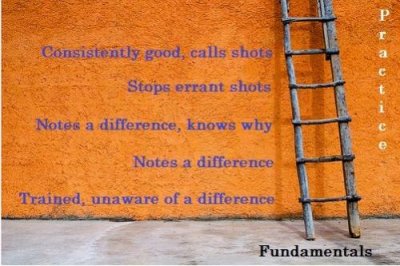Anyone who has watched a great shooter run stages in a dynamic shooting sport has seen him calling his shots. Confirmation he was calling his shot sounded like this:
bang-bang
bang-bang
bang-bang-bang
bang-bang
Those three shots on the third target were when he fired one of the first two shots errant, recognized it as an errant shot, and immediately made it up with a better shot. Anyone looking at his target would likely see two center of the target hits and one out on the edge or missing completely. Calling shots (seeing and feeling if it were accurate or errant, and why) is not an advanced technique. It is shooting, and shooting is simple. To understand what is in play, please imagine a ladder standing on the ground, leaning against a wall.
The Ground in this analogy is a foundation of proper fundamentals. Unfortunately, most people are not climbing the ladder to better shooting because they have no clue what it means to properly fire a shot. A shooter who does not know how to sight the gun or press the trigger properly will never know how good shots feel or how bad shots differ. Knowing how to fire a fundamentally sound shot is required to calling the shot. The shot-calling ladder may stand on the ground of proper fundamentals, but it leans against the wall of practice.
Practice provides opportunity to see and feel the difference between good and bad shots. A shooter should be engaged in live-fire practice at least once a week and dry-fire practice three times a week. Fundamentals must be exercised, tested and reviewed. A shooter can only step onto the first rung once grounded in fundamentals and practicing.
Rung 1: Those on the first rung are properly trained. More than half of their shots are accurate. When they fire an errant shot however, they could not tell you it was different. This shooter fires 5 shots with shots 2 and 5 errant but can’t tell you which of the shots were poorly executed. This shooter is still too deeply a conscious competent- he is too engrossed in what he is doing to have a second awareness of what he did. The great news is that those who are properly trained and are practicing should not remain on rung 1 for long.
Rung 2: A person who learns to fire fundamentally good shots and is practicing will move himself from conscious competence into unconscious competence. In an unconscious competent state the physical acts required to fire a good shot start becoming subconscious acts. When the physical acts are subconscious, the conscious is free to observe the gun and feel the shot. On the second rung the shooter can correctly state that shots 2 and 5 were errant. The shooter noted something felt “different” about those shots even if he is uncertain as to what exactly was different. From rung 2 it is an easy step to rung 3 and knowing how the shot was different.
Rung 3: Having made the physical acts of good shooting rote, and been able to step back a bit from the shooting to “see and feel” shot, the shooter can begin calling the shot. When asked which shots were errant he can state not only that shots 2 and 5 were errant but why they were errant as well. The shooter knows he gave a pre-ignition push or that he slapped at or jerked the trigger. Climbing rungs 1 through 3 hasn’t significantly improved a person’s shooting. Instead, it has prepared the shooter for significant improvement beginning on rung 4.
Rung 4: With the ability to identify which shots were errant and why, the shooter is prepared to stop himself from firing those errant shots. If the shooter knows he slapped the trigger he knows what slapping the trigger feels like. If the shooter know what it feels like to slap the trigger, he can feel himself preparing to slap the trigger the next time… so he should stop. Stop. He should not fire that errant shot. It is important he execute only fundamentally sound shots in live-fire so that he only ever fires fundamentally sound shots. The more a shooter practices fundamentally sound shooting the better he will become, and quickly at that.
Rung 5: Through singular reinforcement of fundamentally sound shooting, errant shots are nearly eliminated. The shooter is vastly improving in speed and accuracy due to confidence, unconscious competence, and raw skill. When the shooter does fire an errant shot he simply makes it up with a fundamentally sound shot.
Through a combination of solid fundamentals and practice, a shooter can move himself from being a conscious competent shooter to an unconscious competent shooter. As he fires more good shots requiring less conscious attention he can become aware of the difference between good shots and errant shots. With a bit of introspection he can declare not only that the shot was errant but why. Once he can feel the difference between good and bad shots, he can stop himself from firing those bad shots and develop the habit of good shooting. The habit of good shooting produces great shooters.

bang-bang
bang-bang
bang-bang-bang
bang-bang
Those three shots on the third target were when he fired one of the first two shots errant, recognized it as an errant shot, and immediately made it up with a better shot. Anyone looking at his target would likely see two center of the target hits and one out on the edge or missing completely. Calling shots (seeing and feeling if it were accurate or errant, and why) is not an advanced technique. It is shooting, and shooting is simple. To understand what is in play, please imagine a ladder standing on the ground, leaning against a wall.
The Ground in this analogy is a foundation of proper fundamentals. Unfortunately, most people are not climbing the ladder to better shooting because they have no clue what it means to properly fire a shot. A shooter who does not know how to sight the gun or press the trigger properly will never know how good shots feel or how bad shots differ. Knowing how to fire a fundamentally sound shot is required to calling the shot. The shot-calling ladder may stand on the ground of proper fundamentals, but it leans against the wall of practice.
Practice provides opportunity to see and feel the difference between good and bad shots. A shooter should be engaged in live-fire practice at least once a week and dry-fire practice three times a week. Fundamentals must be exercised, tested and reviewed. A shooter can only step onto the first rung once grounded in fundamentals and practicing.
Rung 1: Those on the first rung are properly trained. More than half of their shots are accurate. When they fire an errant shot however, they could not tell you it was different. This shooter fires 5 shots with shots 2 and 5 errant but can’t tell you which of the shots were poorly executed. This shooter is still too deeply a conscious competent- he is too engrossed in what he is doing to have a second awareness of what he did. The great news is that those who are properly trained and are practicing should not remain on rung 1 for long.
Rung 2: A person who learns to fire fundamentally good shots and is practicing will move himself from conscious competence into unconscious competence. In an unconscious competent state the physical acts required to fire a good shot start becoming subconscious acts. When the physical acts are subconscious, the conscious is free to observe the gun and feel the shot. On the second rung the shooter can correctly state that shots 2 and 5 were errant. The shooter noted something felt “different” about those shots even if he is uncertain as to what exactly was different. From rung 2 it is an easy step to rung 3 and knowing how the shot was different.
Rung 3: Having made the physical acts of good shooting rote, and been able to step back a bit from the shooting to “see and feel” shot, the shooter can begin calling the shot. When asked which shots were errant he can state not only that shots 2 and 5 were errant but why they were errant as well. The shooter knows he gave a pre-ignition push or that he slapped at or jerked the trigger. Climbing rungs 1 through 3 hasn’t significantly improved a person’s shooting. Instead, it has prepared the shooter for significant improvement beginning on rung 4.
Rung 4: With the ability to identify which shots were errant and why, the shooter is prepared to stop himself from firing those errant shots. If the shooter knows he slapped the trigger he knows what slapping the trigger feels like. If the shooter know what it feels like to slap the trigger, he can feel himself preparing to slap the trigger the next time… so he should stop. Stop. He should not fire that errant shot. It is important he execute only fundamentally sound shots in live-fire so that he only ever fires fundamentally sound shots. The more a shooter practices fundamentally sound shooting the better he will become, and quickly at that.
Rung 5: Through singular reinforcement of fundamentally sound shooting, errant shots are nearly eliminated. The shooter is vastly improving in speed and accuracy due to confidence, unconscious competence, and raw skill. When the shooter does fire an errant shot he simply makes it up with a fundamentally sound shot.
Through a combination of solid fundamentals and practice, a shooter can move himself from being a conscious competent shooter to an unconscious competent shooter. As he fires more good shots requiring less conscious attention he can become aware of the difference between good shots and errant shots. With a bit of introspection he can declare not only that the shot was errant but why. Once he can feel the difference between good and bad shots, he can stop himself from firing those bad shots and develop the habit of good shooting. The habit of good shooting produces great shooters.

Last edited:






